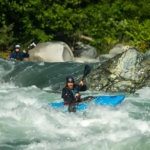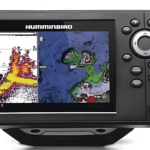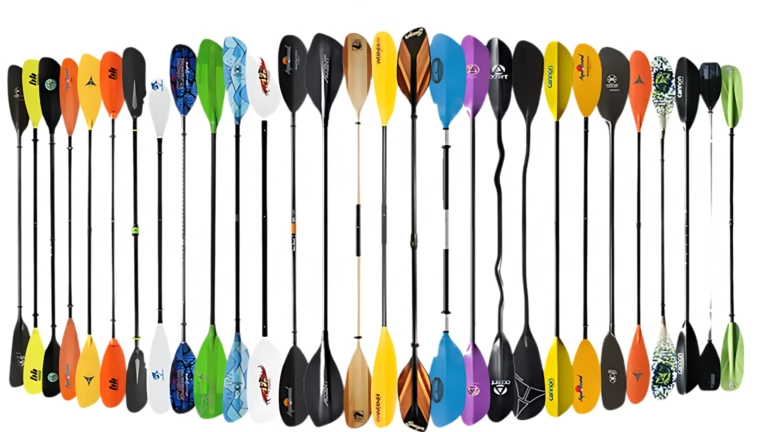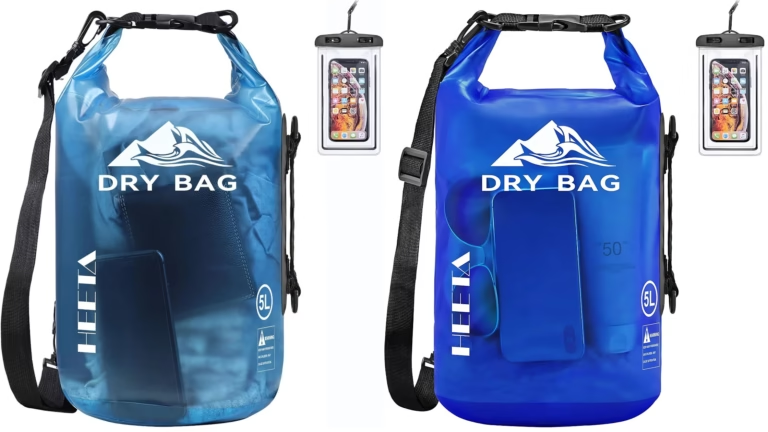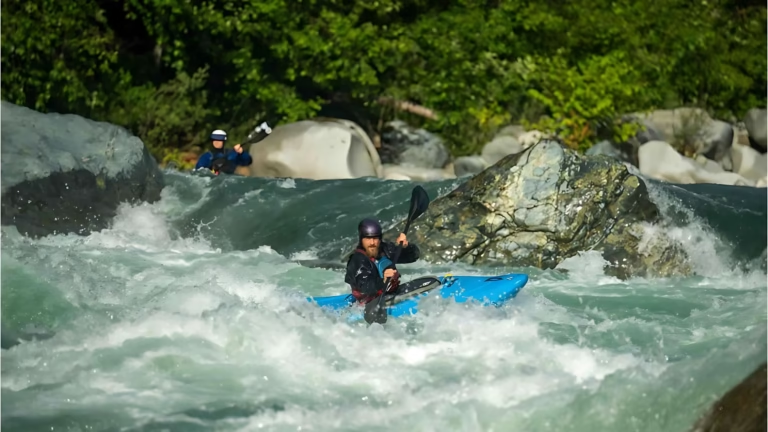The best kayak paddles for long-distance paddling are lightweight, durable, and ergonomically designed. They enhance comfort and efficiency on the water.
Choosing the right kayak paddle is crucial for long-distance journeys. Lightweight materials, such as carbon fiber or fiberglass, reduce fatigue and increase paddling efficiency. Ergonomically designed handles and blades offer better grip and control, minimizing strain on your wrists and shoulders.
Adjustable lengths can accommodate different paddling styles and water conditions. Investing in a high-quality paddle not only improves your performance but also makes your kayaking experience more enjoyable. Remember, the best paddle for you depends on your personal preferences, paddling style, and the type of kayaking you do.
Introduction To Long-distance Paddling
Long-distance paddling is an exciting adventure. It requires the right equipment. One of the most important items is the kayak paddle. A good paddle makes a big difference. It helps you move efficiently and comfortably. This blog will explore the best paddles for long trips.
Importance Of Quality Paddles
A quality paddle is essential for long-distance kayaking. Comfort is key when paddling for hours. A well-made paddle reduces fatigue. It helps you paddle more miles with ease. Durability is another important factor. A strong paddle withstands the rigors of long journeys. It also ensures safety on the water.
Factors To Consider
When choosing a paddle, consider the following factors:
- Material: Paddles come in different materials like aluminum, fiberglass, and carbon fiber.
- Weight: Lighter paddles are easier to handle over long distances.
- Blade Shape: The shape affects your paddling efficiency. Look for asymmetrical blades.
- Length: The paddle length should match your height and kayak width.
- Shaft Design: Choose between straight and bent shafts. Bent shafts can reduce wrist strain.
| Factor | Importance |
|---|---|
| Material | Lightweight and durable materials are preferred. |
| Weight | Reduces fatigue over long distances. |
| Blade Shape | Affects paddling efficiency and comfort. |
| Length | Should be suitable for your height and kayak width. |
| Shaft Design | Reduces wrist strain, offering better comfort. |
Materials Of Kayak Paddles
Choosing the best kayak paddle for long-distance paddling is crucial. The material of the paddle significantly affects performance and comfort. Let’s explore the three most common materials: Carbon Fiber, Fiberglass, and Aluminum.
Carbon Fiber
Carbon fiber paddles are lightweight and strong. They provide excellent performance and durability. These paddles are ideal for long-distance paddling. They reduce fatigue and improve efficiency. Although expensive, the benefits outweigh the cost for serious paddlers.
| Pros | Cons |
|---|---|
| Lightweight | Expensive |
| Durable | Can be less flexible |
| High performance |
Fiberglass
Fiberglass paddles are a popular choice. They offer a balance between weight and cost. These paddles are lighter than aluminum but heavier than carbon fiber. They provide good durability and performance. Fiberglass paddles are flexible, which can be beneficial for long trips.
- Pros: Lightweight, Affordable, Flexible
- Cons: Less durable than carbon fiber, Heavier
Aluminum
Aluminum paddles are the most affordable option. They are heavier compared to carbon fiber and fiberglass. These paddles are durable and a great choice for beginners. While not ideal for long distances, they are a good entry-level option.
- Pros: Affordable, Durable, Good for beginners
- Cons: Heavy, Can cause fatigue, Less efficient
Blade Shapes And Their Benefits
Choosing the right kayak paddle is vital for long-distance paddling. The blade shape affects your efficiency and endurance. Understanding blade shapes helps you select the best paddle for your needs.
Asymmetrical Blades
Asymmetrical blades are popular among long-distance paddlers. These blades have a smaller top edge and a larger bottom edge. This design reduces flutter and improves stroke efficiency.
Asymmetrical blades provide a balanced stroke. They cut through water smoothly. This reduces strain on your arms and shoulders.
Symmetrical Blades
Symmetrical blades are identical on both sides. They are often used by beginner paddlers. These blades are easy to handle and control.
Symmetrical blades require less skill to use. They are great for leisurely paddling. Their straightforward design makes them reliable and durable.
High-angle Vs. Low-angle
High-angle paddling involves a more vertical stroke. It generates more power and speed. High-angle blades are shorter and wider.
- Benefits of High-Angle Blades:
- Increased power
- Better for rough waters
- Ideal for strong paddlers
Low-angle paddling uses a more horizontal stroke. It is less tiring for long trips. Low-angle blades are longer and narrower.
- Benefits of Low-Angle Blades:
- Less fatigue
- Better for flat waters
- Ideal for relaxed paddling
Choosing between high-angle and low-angle depends on your paddling style. Consider your strength and the water conditions.
Shaft Designs
Choosing the right kayak paddle is vital for long-distance paddling. The shaft design significantly impacts your performance and comfort. Let’s explore the different shaft designs available.
Straight Shafts
Straight shafts are the most common design. They are simple and versatile. Many paddlers find them easy to use. They are typically lightweight and affordable. This makes them ideal for beginners. Straight shafts work well in various water conditions. They offer a natural hand position, reducing strain during long trips.
Bent Shafts
Bent shafts have a slight angle in the middle. This design helps align your wrists better. It reduces wrist fatigue and increases efficiency. Bent shafts are popular for long-distance paddling. They provide better control and power. This is especially beneficial in rough waters. Though they are more expensive, they are worth the investment for serious paddlers.
Two-piece Shafts
Two-piece shafts are adjustable and convenient. They can be taken apart for easy transport. This is great for paddlers who travel often. Two-piece shafts also allow for adjustable feathering. This means you can change the angle of the blades. This feature helps in windy conditions. These shafts are usually durable and offer flexibility in use.
| Shaft Type | Benefits | Ideal For |
|---|---|---|
| Straight Shafts | Lightweight, Affordable, Versatile | Beginners, Various Water Conditions |
| Bent Shafts | Wrist Alignment, Reduced Fatigue, Efficiency | Serious Paddlers, Rough Waters |
| Two-Piece Shafts | Adjustable, Portable, Durable | Travelers, Windy Conditions |
Weight Considerations
When choosing kayak paddles for long-distance paddling, weight is crucial. A lighter paddle reduces fatigue, allowing you to paddle longer. But weight is not the only factor; durability is important too. Let’s explore some key weight considerations for the best kayak paddles.
Lightweight Options
Lightweight paddles are easier on your shoulders and arms. They make your strokes more efficient. Materials like carbon fiber and fiberglass are popular for their light weight.
- Carbon Fiber: Extremely light and stiff. Ideal for long-distance.
- Fiberglass: Lightweight and durable. Good balance of weight and strength.
Durability Vs. Weight
Balancing weight and durability is important. Lightweight paddles may sacrifice some durability. Heavier paddles often last longer but can cause fatigue.
| Material | Weight | Durability |
|---|---|---|
| Carbon Fiber | Very Light | Moderate |
| Fiberglass | Light | High |
| Aluminum | Heavy | Very High |
Choose a paddle that fits your strength and trip length. A balance between weight and durability ensures a comfortable and enduring paddling experience.
Adjustable Length Paddles
Kayaking long distances demands the right equipment. One essential item is the adjustable length paddle. These paddles offer flexibility and comfort, ensuring an optimal experience on the water.
Benefits Of Adjustability
Adjustable length paddles provide numerous benefits:
- Custom Fit: Adjust to your height and arm length.
- Versatility: Suitable for different paddling styles.
- Comfort: Reduces strain on your shoulders and arms.
- Portability: Easy to transport and store.
Popular Adjustable Models
| Model | Length Range | Weight | Material |
|---|---|---|---|
| Werner Camano Adjustable | 220-240 cm | 28 oz | Carbon Fiber |
| Bending Branches Angler Pro | 240-260 cm | 29 oz | Fiberglass |
| Aqua-Bound Manta Ray | 210-230 cm | 30 oz | Carbon Shaft |
Choose an adjustable paddle that fits your needs. Enjoy a comfortable and efficient kayaking experience.
Top Brands And Models
Choosing the right kayak paddle for long-distance paddling is crucial. The right paddle increases efficiency and reduces fatigue. Here are the top brands and models that stand out.
Werner Paddles
Werner Paddles are known for their exceptional quality and performance. They offer lightweight, durable paddles that are perfect for long-distance paddling. Here are some top models:
- Werner Camano: This paddle is light and strong. It features a mid-sized blade, perfect for long trips.
- Werner Shuna: Ideal for high-angle paddlers, this model offers power and control.
- Werner Kalliste: The ultimate choice for long-distance paddling, it is ultra-light and comfortable.
Aqua-bound Paddles
Aqua-Bound Paddles combine technology and craftsmanship. They offer reliable and high-performance paddles. Here are some top models:
- Aqua-Bound Manta Ray Carbon: This paddle is light and powerful. It features a carbon shaft and large blades.
- Aqua-Bound Sting Ray Hybrid: A mix of carbon and fiberglass, it offers balance and efficiency.
- Aqua-Bound Tango: This paddle is ultra-light and provides excellent performance for long trips.
Bending Branches
Bending Branches is known for its innovative designs and durability. They offer paddles that are both lightweight and strong. Here are some top models:
- Bending Branches Navigator: This paddle features a wooden blade and a lightweight shaft, ideal for long distances.
- Bending Branches Angler Pro: Perfect for kayak fishing, this paddle is strong and versatile.
- Bending Branches Whisper: An affordable yet high-quality option, it is durable and efficient.
Maintenance And Care Tips
Proper maintenance and care of your kayak paddle can extend its life. Well-maintained paddles also ensure better performance during long-distance paddling. Follow these tips to keep your paddle in top condition.
Cleaning Your Paddle
Regular cleaning is essential for your paddle. After each use, rinse your paddle with fresh water. This removes salt, sand, and dirt. Use a mild soap if the paddle is very dirty. Avoid harsh chemicals as they can damage the paddle’s surface.
Use a soft brush to scrub stubborn dirt. Rinse thoroughly to remove all soap. Dry the paddle with a soft cloth. Ensure no water remains in the joints or moving parts.
Storage Tips
Proper storage keeps your paddle in good shape. Store your paddle in a cool, dry place. Avoid direct sunlight as it can damage the material.
Hang the paddle horizontally. Use hooks or a paddle rack. Ensure the paddle is not under any pressure. Do not lean it against a wall for long periods. This can cause warping.
For long-term storage, consider using a paddle bag. This protects the paddle from dust and scratches.
| Maintenance Task | Frequency |
|---|---|
| Rinse with fresh water | After each use |
| Clean with mild soap | As needed |
| Dry with soft cloth | After each cleaning |
| Store in cool, dry place | Always |
Frequently Asked Questions
What Makes A Kayak Paddle Good For Long Distances?
A good kayak paddle for long distances is lightweight and durable. It should have an ergonomic design for comfort. Adjustable length and feathering are key features. This reduces strain and improves efficiency.
How Do I Choose A Kayak Paddle Length?
To choose the right kayak paddle length, consider your height and kayak width. A general guide is taller paddlers and wider kayaks need longer paddles. Adjustable paddles offer flexibility.
Are Carbon Fiber Paddles Worth The Cost?
Yes, carbon fiber paddles are worth the cost for long-distance paddling. They are extremely lightweight and durable. This reduces fatigue and improves performance.
What Is Feathering In Kayak Paddles?
Feathering in kayak paddles refers to the offset angle between the blades. This reduces wind resistance during paddling. Adjustable feathering allows customization to your preference.
Conclusion
Choosing the right kayak paddle is essential for long-distance paddling. The best paddles improve comfort and efficiency. Prioritize lightweight materials and ergonomic designs. Invest in a quality paddle for a better kayaking experience. Happy paddling!

